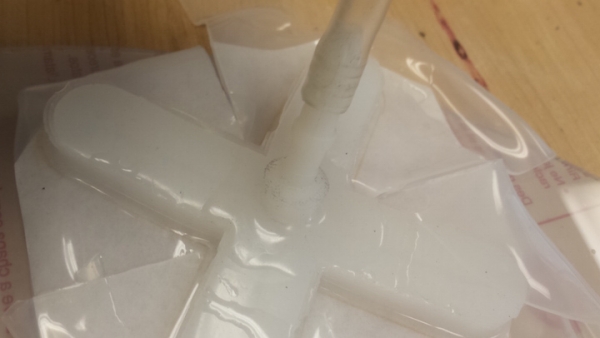First, we used an Instructable by Ben Finio for a PneuNet gripper. We made a mold made of ecoflex 30 (combo of components A and B) with an air cavity inside it. The mold itself had the shape of a square cross with semi-circular tips. We made 3-5 of these molds but eventually, all failed or malfunctioned because of one or more of the following reasons: Only one of the grabber’s arms inflated, air bubbles formed in the mold, and/or the appearance of rips and tears on the edges and corners of the mold. Eventually, we decided to take on a new design from Harrison_89 from Instructables for a Fiber Reinforced design. We opted to make a grabber with only 3 arms but slightly larger and stronger. Previously, we made the mold cast using a 3D printer but this time, we made it out of cardboard. Then, we made a second, thinner mold which would serve as the base of the grabber. Once we attached the two molds and covered it with curling ribbon, it worked but not as effectively as we would have liked. In addition, a single leak appeared which complicated things. Eventually, we used our final batches of ecoflex and with all our care and passion, created the perfect 4-arm gripper which worked repeatedly. Although all the arms still did not inflate at the same time, the gripper was successful in lifting objects less than 3/2 pounds. The addition of sticky tape and magnets further amplified our successes.
We also needed to find a way to attach the gripper to the PVC pipe arm. Most glues and tapes do not stick to ecoflex, so we needed a mechanical fastening. We decided to strap down the gripper with tape attached to the PVC arm, and this worked reasonable well and gave us a mounting point for the magnets.
However, we also wanted some more support laterally, so we wanted to attach an ecoflex plug to the end of the gripper that would snugly fit inside the PVC arm. This also helped hold the barbed connector to supply air to the gripper.
 |
We found that we could push the barbed connectors though a pinhole in the ecoflex to make a secure barbed connection to ecoflex with our 1/4 inch barbs. This would cause the ecoflex to expand.
To design our connecting plugs, first we assumed that ecoflex was incomprehensible and kept constant volume. Then we took the total volume of the plug and subtracted out the volume of the barb. Finally, we used this volume to find the radius of a cylinder with that volume and the correct height of the plug. We 3d printed a mold for this and it worked out well.
